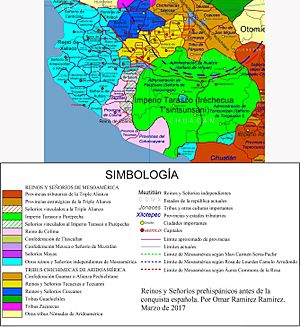Saltpeter War (Mexico) facts for kids
Quick facts for kids Salitre War |
|||||||
|---|---|---|---|---|---|---|---|
 |
|||||||
|
|||||||
| Belligerents | |||||||
| Tarascan state |
Colima Sayula Zapotlán Tapalpa Autlán |
||||||
| Commanders and leaders | |||||||
| Tangaxuan II | |||||||
The Salitre War (also known as the Saltpeter War) was a military conflict that took place between 1480 and 1510. It was fought in Mesoamerica, which is now part of Mexico. The main groups involved were the powerful Tarascan state and several smaller communities. These communities included people from Colima, Sayula, Zapotlán, Tapalpa, and Autlán.
The war began when the Purépecha ruler, Tangaxuan II, decided to invade these areas. His main goal was to take control of the valuable mining sites where saltpeter (also known as sodium nitrate) was found. This important mineral gave the war its name. The conflict ended with the Purépecha being forced out of the regions of Colima and Jalisco.
Contents
Why Was Saltpeter So Important?
Saltpeter, or sodium nitrate, was a very important mineral in ancient times. It was used for many things, including making gunpowder, which was crucial for warfare. It was also used in some medicines and for preserving food. Because it was so useful, any group that controlled saltpeter mines had a big advantage. The areas around Colima and Jalisco were rich in this valuable resource.
The Purépecha Empire, also known as the Tarascan state, was a powerful kingdom in Mesoamerica. They wanted to expand their control and gain access to more resources. Taking over the saltpeter mines would make their empire even stronger. This desire for control over resources often led to conflicts between different groups in ancient times.
Who Fought in the War?
On one side was the Tarascan state. This was a large and well-organized empire with a strong army. Their leader during this time was Tangaxuan II, who made the decision to invade the saltpeter-rich lands. The Purépecha people were known for their advanced metalworking skills and their military strength.
On the other side were several independent communities and smaller states. These included the people of Colima, Sayula, Zapotlán, Tapalpa, and Autlán. These groups were defending their lands and their valuable saltpeter mines from the Purépecha invasion. They had to work together to protect their homes and resources.
How the War Unfolded
The Salitre War lasted for about 30 years, from 1480 to 1510. It started with the Purépecha invasion led by Tangaxuan II. The Purépecha army moved into the territories of Colima and Jalisco, aiming to seize the mines.
The conflict was likely a series of battles and skirmishes over many years. The local communities fought hard to resist the powerful Purépecha Empire. While specific battle details are not widely known, the long duration of the war suggests it was a tough fight for both sides.
What Happened After the War?
Despite the Purépecha Empire's strength, the war ended with their defeat in these specific areas. The result was the "expulsion of Purépecha from Colima and Jalisco." This means that the Purépecha forces were pushed out of these regions.
This outcome was a significant victory for the local communities. It allowed them to keep control of their saltpeter mines and maintain their independence from the Purépecha Empire. The Salitre War shows how important natural resources could be in shaping conflicts and borders in ancient Mesoamerica.
See also
 In Spanish: Guerra del Salitre (México) para niños
In Spanish: Guerra del Salitre (México) para niños

